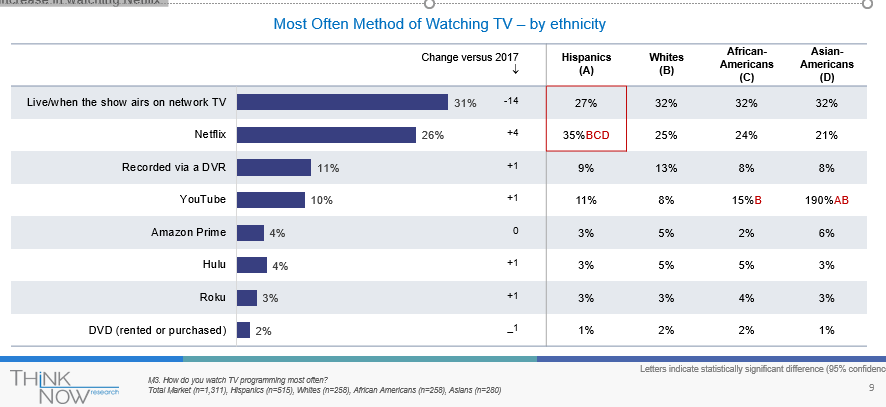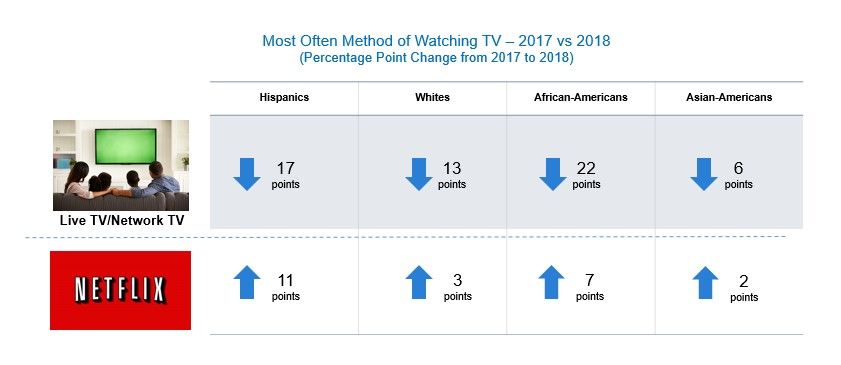Total Market Viewers Favor Live TV, Multicultural Audiences Switch To Streaming
Years ago, TV viewers watched and recorded their favorite shows on cable. Chained to our VCRs, we collected episode laden VHS tapes like squirrels collect nuts in the winter. Then DVRs came along, liberating us from reels of magnetic tape and wooing us with the allure of live TV on our own terms. Flash forward a few years. Streaming services disrupt TV as we know it. Viewers now have the option to stream entire seasons of shows from every genre, from throwbacks like The Wonder Years and Full House to Game of Thrones and Westworld, and everything in between.
Traditional networks broadcast live shows and make them available via streaming services or release the entire season, as was the case with the short-lived David Duchovny series Aquarius. “We are fully aware how audiences want to consume multiple episodes of new television series faster and at their own discretion…” NBC Entertainment Chairman Bob Greenblatt explained after the decision to stream all 13 episodes after the show’s two-hour network premiere.
At ThinkNow, we’ve studied this shift in media consumption for three years now. Our ThinkNow Media™ report tracks cross-platform viewing, streaming habits, gaming, and binge viewing habits across the total market. This report a decade ago would have shown little movement in consumer media consumption habits as Netflix would have just been offering their streaming services and live TV held onto its decade's long dominance of viewers. But now, Netflix is crushing it. Its market cap has exceeded Disney’s. Amazon has become a significant driver of subscriptions for TV companies. Fortnite has become a cultural phenomenon, and AT&T and Time Warner are on the verge of a potential merger.
It is within this tumultuous media climate that we delved into media consumption habits of a representative sample of U.S. Hispanics, African-Americans, Asians, and non-Hispanic whites to get more granular on who within the body of viewers are driving these changes. In this blog, we will highlight several key insights of the ThinkNow Media™ report that will help advertisers better understand the new normal for media consumption. For the full report, please download here.
Live TV Viewership Continues to Decline
We asked respondents, “what are the ways that you watch TV programming?” When looking at all methods, we see that live TV/network TV plummeted, dropping from 68% to 48%, a whopping 20-point decline when looking at all methods of watching TV programming.
This drop is tempered slightly (but not much) when we look at how viewers are watching TV programming most often, dipping from 45% in 2017 to 31% in 2018, a 14-point decline. Despite the decline, live TV continues to top the list on how TV programming is watched most often.
Netflix Continues Its Rise
TV isn’t dead but has been on the decline for some time now. But what is driving the decline? You guessed it, Netflix. The streaming powerhouse ranks second to live TV in viewer preference and has a wide margin over other options, particularly DVR and YouTube. When looking at all methods of watching TV programming, Netflix has risen 3% from 58% in 2017 to 61% in 2018:
Looking at an arguably even more critical metric, most often viewed method, Netflix rises 4% points from 22% in 2017 to 26% in 2018.
Hispanics Favor Netflix Over Live TV
While live TV continues to top the list of how TV programming is watched most often among the Total Market, that lead is narrow, however, as ‘on demand’ watching continues to gain ground. Hispanics are leading Netflix’s rise to the top as the only segment who reports favoring Netflix over live TV. Thirty-five percent of U.S. Hispanics report Netflix as how they watch TV programming most often.
This is not surprising considering that Hispanics tend to be early adopters of technology and over-index on mobile phone use and video consumption. Conversely, live TV viewing is lowest among Hispanics.
African-Americans Driving Decline of Live TV
While Hispanics are the only segment in which Netflix beat out live TV, African-Americans had the largest percentage point decline in live TV viewing. African-Americans showed a 22-point decline in live TV viewing from 2017 to 2018. Hispanics and non-Hispanic Whites come in at 2nd and 3rd respectively with a 17 point and 13-point decline. Asian-Americans have been the slowest to let go of their live TV viewing habits with a relatively small decline of 6 points in live TV viewing from 2017 to 2018.
Binge Viewing Is Losing Its Novelty
While Netflix seems to be dominating across several key metrics, one metric that we have measured the past several years has experienced its first decline, binge viewing. ThinkNow has defined binge viewing as watching 3 or more episodes in one viewing. Perhaps more viewers are aware of the potential health hazards related to binge viewing, or the novelty of watching several episodes in one viewing is wearing off.
The decrease is minimal, however, with the Total Market preferring to watch 3.7 episodes in 2017 now dipping to 3.4 episodes in 2018. This trend is not consistent, however, across all groups. African-Americans saw a slight increase in number of episodes watched in one viewing from 3.9 episodes in 2017 to 4.2 in 2018. This could be driven by the precipitous decline of live TV watching among African-Americans and increase in Netflix adoption.
Console Gaming Declining in Favor of Mobile
The popularity of Fortnite might have us think otherwise, but the data indicates that console and computer gaming is experiencing a substantial decline along with video games, in general.
When we asked, “which of the following video-game related activities have you done in the past 12 months?” among a representative Total Market sample, “played a video game on a laptop or desktop computer” declined 11 points from 41% in 2017 to 30% in 2018. Console gaming dropped 6 points, from 39% in 2017 to 33% in 2018.
So, what’s driving the decline of gaming on consoles and computers? One constant that the data points to is mobile. While mobile gaming experienced a slight decline of 3 points from 46% in 2017 to 43% to 2018, this is a minimal decrease in comparison to console and computer gaming. The fact that mobile gaming is staying relatively stable suggests a preference for mobile gaming.
But the overall decline in video gaming, in general, perhaps makes the most significant impact on the current state of console and computer gaming. Respondents indicating that they do not engage in any video-game related activities increased 9 points from 24% in 2017 to 33% in 2018. This decline is driven primarily by non-Hispanic whites and African-Americans.
The End Game
Streaming services will probably never replace live TV entirely, but it has changed the way viewers think about watching their favorite shows. As TVs get smarter, now equipped with YouTube and other streaming services, it is easier than ever to bypass live TV and take control of your viewing experience. Many factors play into the shifts in media consumption. But for multicultural audiences, it becomes a matter of culture and how they consume media in the confines of what is important to them. For marketers, understanding the medium of viewership is only a part of the equation. Looking at the cultural factors that influence those decisions is where the advantage lies.
Download our detailed report here:

